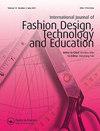{"title":"原型开发:speakeasy©面具","authors":"Sydney Fava, Abigail Nichols, Madison Ratledge, Charles Freeman, Reuben F. Burch, John Wilson, Jaime G. Rickert, Catherine Black","doi":"10.1080/17543266.2022.2065537","DOIUrl":null,"url":null,"abstract":"ABSTRACT Speak-Easy© prototype masks came from efforts to assist in the communication process for individuals with hearing limitations or individuals whose jobs that require seeing lip movement. Masks can muffle speech and make communication more difficult. The Functional, Expressive, and Aesthetic (FEA) Consumer Needs model provided the conceptual framework for the study. This project provided hands-on experience for student and faculty collaborative to address consumers’ needs. For the project, two Speak-Easy© prototype mask variations were designed and constructed. The Speak-Easy© I design goal was to provide ease of seeing lip movement and a basic pattern for individuals with sewing skills. The Speak-Easy© I mask performed within end-user expectations and needs and outperformed many non-medical fabric masks tested for FE and dP. The Speak-Easy© II prototype mask was designed to stand away from the wearer’s face, to be comfortable throughout the workday, and provide a fog-free transparent window for ease of lip-reading.","PeriodicalId":39443,"journal":{"name":"International Journal of Fashion Design, Technology and Education","volume":"11 1 1","pages":"342 - 350"},"PeriodicalIF":1.9000,"publicationDate":"2022-05-19","publicationTypes":"Journal Article","fieldsOfStudy":null,"isOpenAccess":false,"openAccessPdf":"","citationCount":"0","resultStr":"{\"title\":\"Prototype development: the Speak-Easy© mask\",\"authors\":\"Sydney Fava, Abigail Nichols, Madison Ratledge, Charles Freeman, Reuben F. Burch, John Wilson, Jaime G. Rickert, Catherine Black\",\"doi\":\"10.1080/17543266.2022.2065537\",\"DOIUrl\":null,\"url\":null,\"abstract\":\"ABSTRACT Speak-Easy© prototype masks came from efforts to assist in the communication process for individuals with hearing limitations or individuals whose jobs that require seeing lip movement. Masks can muffle speech and make communication more difficult. The Functional, Expressive, and Aesthetic (FEA) Consumer Needs model provided the conceptual framework for the study. This project provided hands-on experience for student and faculty collaborative to address consumers’ needs. For the project, two Speak-Easy© prototype mask variations were designed and constructed. The Speak-Easy© I design goal was to provide ease of seeing lip movement and a basic pattern for individuals with sewing skills. The Speak-Easy© I mask performed within end-user expectations and needs and outperformed many non-medical fabric masks tested for FE and dP. The Speak-Easy© II prototype mask was designed to stand away from the wearer’s face, to be comfortable throughout the workday, and provide a fog-free transparent window for ease of lip-reading.\",\"PeriodicalId\":39443,\"journal\":{\"name\":\"International Journal of Fashion Design, Technology and Education\",\"volume\":\"11 1 1\",\"pages\":\"342 - 350\"},\"PeriodicalIF\":1.9000,\"publicationDate\":\"2022-05-19\",\"publicationTypes\":\"Journal Article\",\"fieldsOfStudy\":null,\"isOpenAccess\":false,\"openAccessPdf\":\"\",\"citationCount\":\"0\",\"resultStr\":null,\"platform\":\"Semanticscholar\",\"paperid\":null,\"PeriodicalName\":\"International Journal of Fashion Design, Technology and Education\",\"FirstCategoryId\":\"1085\",\"ListUrlMain\":\"https://doi.org/10.1080/17543266.2022.2065537\",\"RegionNum\":0,\"RegionCategory\":null,\"ArticlePicture\":[],\"TitleCN\":null,\"AbstractTextCN\":null,\"PMCID\":null,\"EPubDate\":\"\",\"PubModel\":\"\",\"JCR\":\"Q3\",\"JCRName\":\"BUSINESS\",\"Score\":null,\"Total\":0}","platform":"Semanticscholar","paperid":null,"PeriodicalName":"International Journal of Fashion Design, Technology and Education","FirstCategoryId":"1085","ListUrlMain":"https://doi.org/10.1080/17543266.2022.2065537","RegionNum":0,"RegionCategory":null,"ArticlePicture":[],"TitleCN":null,"AbstractTextCN":null,"PMCID":null,"EPubDate":"","PubModel":"","JCR":"Q3","JCRName":"BUSINESS","Score":null,"Total":0}
引用次数: 0


